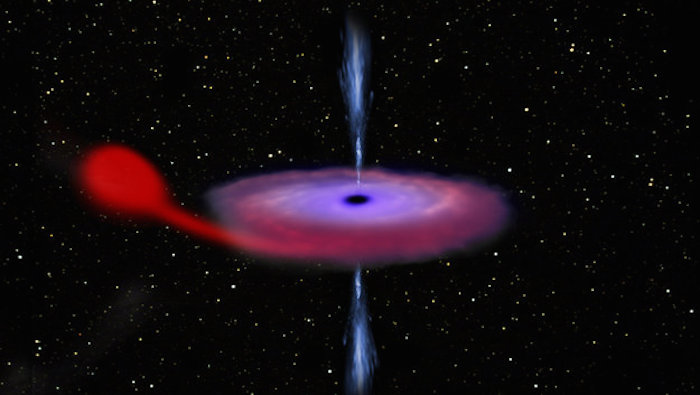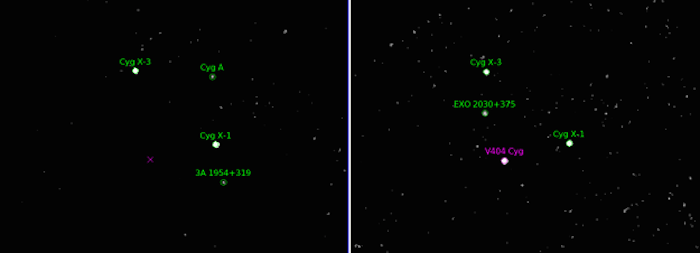.

Over the past week, ESA's Integral satellite has been observing an exceptional outburst of high-energy light produced by a black hole that is devouring material from its stellar companion.
X-rays and gamma rays point to some of the most extreme phenomena in the Universe, such as stellar explosions, powerful outbursts and black holes feasting on their surroundings.
In contrast to the peaceful view of the night sky we see with our eyes, the high-energy sky is a dynamic light show, from flickering sources that change their brightness dramatically in a few minutes to others that vary on timescales spanning years or even decades.
On 15 June 2015, a long-time acquaintance of X-ray and gamma ray astronomers made its comeback to the cosmic stage: V404 Cygni, a system comprising a black hole and a star orbiting one another. It is located in our Milky Way galaxy, almost 8000 light-years away in the constellation Cygnus, the Swan.
In this type of binary system, material flows from the star towards the black hole and gathers in a disc, where it is heated up, shining brightly at optical, ultraviolet and X-ray wavelengths before spiralling into the black hole.
First signs of renewed activity in V404 Cygni were spotted by the Burst Alert Telescope on NASA's Swift satellite, detecting a sudden burst of gamma rays, and then triggering observations with its X-ray telescope. Soon after, MAXI (Monitor of All-sky X-ray Image), part of the Japanese Experiment Module on the International Space Station, observed an X-ray flare from the same patch of the sky.
These first detections triggered a massive campaign of observations from ground-based telescopes and from space-based observatories, to monitor V404 Cygni at many different wavelengths across the electromagnetic spectrum. As part of this worldwide effort, ESA's Integral gamma-ray observatory started monitoring the out-bursting black hole on 17 June.
.

Integral image before and after the outburst
“The behaviour of this source is extraordinary at the moment, with repeated bright flashes of light on time scales shorter than an hour, something rarely seen in other black hole systems,” comments Erik Kuulkers, Integral project scientist at ESA.
“In these moments, it becomes the brightest object in the X-ray sky – up to fifty times brighter than the Crab Nebula, normally one of the brightest sources in the high-energy sky.”
The V404 Cygni black hole system has not been this bright and active since 1989, when it was observed with the Japanese X-ray satellite Ginga and high-energy instruments on board the Mir space station.
“The community couldn't be more thrilled: many of us weren't yet professional astronomers back then, and the instruments and facilities available at the time can’t compare with the fleet of space telescopes and the vast network of ground-based observatories we can use today. It is definitely a 'once in a professional lifetime' opportunity,” adds Kuulkers.
Quelle: ESA
4195 Views
